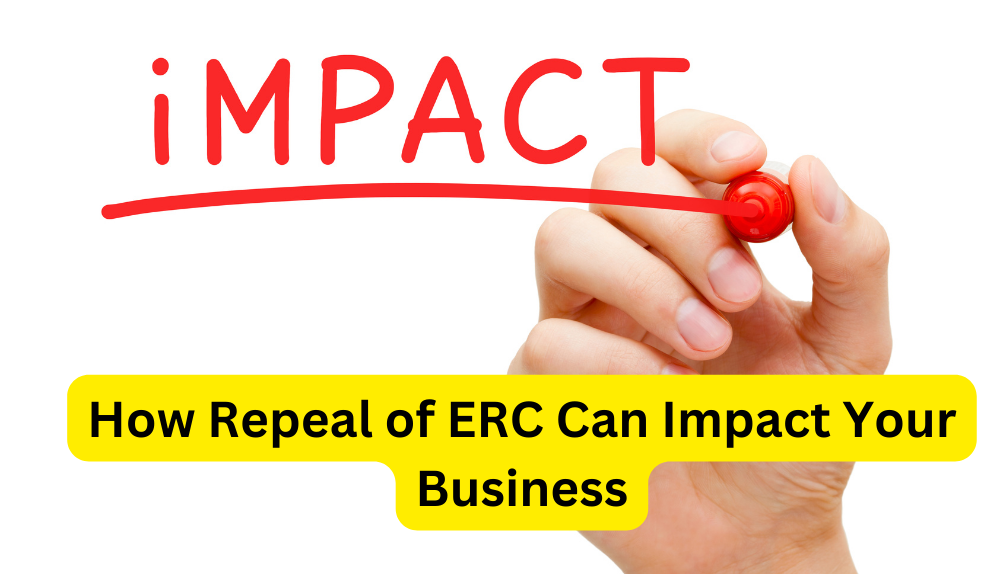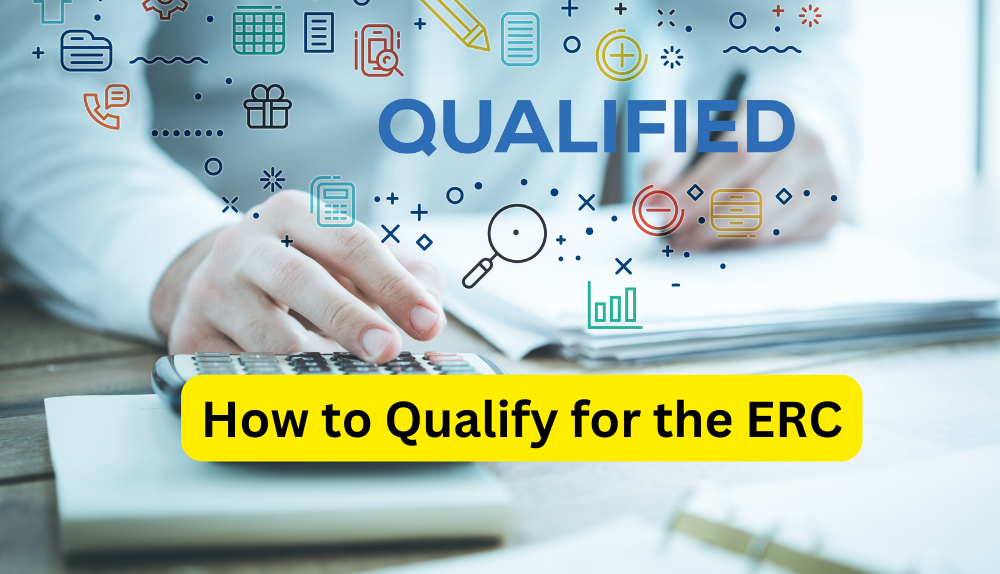The Employee Retention Credit (ERC) was a support program for businesses, helping them during tough times. However, a new law called the Infrastructure Investment and Jobs Act (IIJA) has removed this credit for most employers. This change happened in September 2021, and the ERC is no longer available. But if your business is eligible and you haven’t claimed the credit yet, you still have a chance to do so for the periods it covered. This article will help you understand what this means for your business and how you can qualify for the ERC and handle this situation to keep your business going.
ERC Timeline
The Employee Retention Credit (ERC) has undergone significant changes and developments since its inception. The timeline of the ERC is as follows:

- March 13, 2020: The ERC was introduced as part of the CARES Act in response to the COVID-19 pandemic. It provided eligible businesses with a credit of up to 50% of qualified wages paid to employees during the period from March 13 to December 31, 2020.
- December 27, 2020: The Consolidated Appropriations Act, 2021, was signed into law, extending and expanding the ERC. The credit percentage was increased to 70% of qualified wages, and the eligibility period was extended to June 30, 2021.
- March 11, 2021: The American Rescue Plan Act was enacted, further extending and expanding the ERC. It extended the eligible period to December 31, 2021, allowing businesses to claim the credit for all four quarters of 2021.
- September 30, 2021: The Infrastructure Investment and Jobs Act repealed the ERC for most employers, making it unavailable for wages that were paid after September 30, 2021.
Throughout its timeline, the ERC has played a crucial role in providing financial assistance to businesses affected by the pandemic. However, the legislative updates and expiration dates have brought changes and implications for businesses seeking to claim this valuable credit.
How Repeal of ERC Can Impact Your Business
The repeal of the Employee Retention Credit (ERC) on September 30, 2021, has significant implications for businesses that were expecting to benefit from this credit during the 4th quarter of 2021. Many businesses may have planned their budgets and reduced their tax deposits, assuming they would receive the ERC for that period. With the credit no longer available, affected businesses now need to address certain issues and understand the consequences of the ERC repeal.

Repaying Advanced ERC Payments
If your business received advanced ERC payments for the 4th quarter of 2021 but did not qualify as a recovery startup business, you have the option to avoid “failure to pay” penalties. To do so, you must repay the advance payments by the due date of your applicable employment tax return.
Impact of Reduced Employment Tax Deposits
For businesses that reduced their tax deposits on or before December 20, 2021, for wages paid in the fourth quarter of 2021 and are not considered recovery startup businesses, “failure to deposit” penalties may not apply under certain conditions. These conditions include:
- Reducing deposits based on the rules specified in Notice 2021-24.
- Depositing the amount initially retained on or before the relevant due date for wages paid on December 31, 2021 (the deposit due date varies based on your deposit schedule).
- Reporting the tax liability resulting from the termination of the Employee Retention Credit on the applicable employment tax return or schedule that covers the period from October 1, 2021, through December 31, 2021.
- Additional information on how to report the tax liability can be found in the instructions or schedule for the applicable employment tax return.
Qualified Recovery Startup Businesses
Recovery startup businesses have a chance to claim the ERC through December 2021 if they meet specific criteria. To qualify as a recovery startup business, your company must:
- Have started operations on or after February 15, 2020.
- Maintain average annual gross receipts not exceeding $1 million.
- Employ one or more employees (excluding 50% owners).
- Have an annual gross income of less than $1 million.
- Not already be eligible for ERC due to a suspension of operations or decline in gross receipts.
If your business is a qualified recovery startup, you can claim the ERC for the fourth quarter of 2021 by complying with all the rules outlined in Notice 2021-20, Notice 2021-23, and Notice 2021-49, which address CARES Act provisions similar to those provided under Section 3134 of the Code.
As the ERC repeal impacts various businesses differently, it is crucial for business owners and tax professionals to stay informed and take appropriate actions to comply with the new regulations. Understanding the implications of the ERC repeal and following the guidelines provided by the IRS can help businesses avoid penalties and maintain financial stability during these challenging times.
How to Qualify for the ERC
Qualifying for the Employee Retention Credit (ERC) involves meeting specific criteria set by the IRS. The ERC is designed to provide financial assistance to eligible businesses that faced challenges during certain periods, such as the COVID-19 pandemic. To qualify for the ERC, businesses need to fulfill the following requirements:

Experience a Qualifying Shutdown or Significant Decline in Gross Receipts:
For wages paid between March 13, 2020, and December 31, 2021, businesses must have experienced either:
- A partial or full suspension of operations caused by government orders related to COVID-19, or
- A significant drop in gross receipts.
A major drop in gross receipts typically means a decrease of 50% or more in gross receipts compared to the same calendar quarter in the previous year. However, for 2021, the threshold was lowered to 20% due to new legislation.
Number of Full-Time Employees
The number of full-time employees a business has plays a role in determining eligibility. For wages paid between March 13, 2020, and December 31, 2021, businesses with an average of 100 or fewer full-time employees in 2019 are eligible for the ERC, regardless of whether they experienced a qualifying shutdown or drop in gross receipts.
Claiming Periods
The ERC is available for specific periods. For example, for wages paid after March 12, 2020, and before January 1, 2021, the business must have either completely or partially stopped operating, or its total sales must have dropped significantly. Additionally, for wages paid after December 31, 2020, and before July 1, 2021, the eligibility criteria expanded, and businesses could claim the ERC even if they experienced a drop in gross receipts but did not face a partial or full suspension of operations.
Governmental Orders
If a business faced a suspension of operations due to governmental orders, they need to demonstrate that those orders were the reason for the shutdown and that they impacted their ability to continue normal operations.
Ownership Requirements
Businesses with common ownership or certain relationships with other entities may have to consider aggregated rules that can affect their eligibility.
It is essential to note that the specific requirements for the ERC may change due to legislative updates or new guidance from the IRS. As such, businesses should regularly check the IRS website and consult with tax professionals to ensure they meet all the qualifying criteria and can claim the ERC accurately. Proper documentation is also critical to support the eligibility for the credit and to avoid potential issues during IRS audits.
ERC Credit Amount for 2020
The maximum amount of eligible wages that could be considered for the ERC was $10,000 per employee for the entire 2020 period. This means the maximum credit per eligible employee for 2020 was $5,000 (50% of $10,000).
To qualify for the ERC in 2020, businesses had to meet specific criteria, including experiencing a partial or full suspension of operations due to government orders related to COVID-19 or a large decrease in gross receipts from the same quarter in 2019.
ERC Credit Amount for 2021
For the first two quarters of 2021 (Q1 and Q2), the ERC allowed businesses to claim a credit of up to $7,000 per employee each quarter. This means eligible businesses could potentially receive a full credit of $14,000 per employee for the first half of 2021.
For the last two quarters of 2021 (Q3 and Q4), the ERC was further expanded, allowing businesses to claim a credit of up to $7,000 per employee each quarter as well. Hence, the maximum credit per eligible employee for the entire 2021 year was $28,000 ($7,000 per quarter for Q1, Q2, Q3, and Q4).
To qualify for the ERC in 2021, businesses needed to meet specific criteria, including experiencing either a partial or full suspension of operations due to government orders related to COVID-19. The threshold for a noteworthy drop in gross receipts was lowered to 20% for 2021, making more businesses eligible for the credit.
Final Words
In conclusion, the Employee Retention Credit (ERC) has been a significant lifeline for businesses facing the challenges of the COVID-19 pandemic. From its introduction in the CARES Act to its expansion and extension through subsequent legislation, the ERC has provided much-needed financial support to eligible businesses, allowing them to retain employees and stay afloat during uncertain times. However, with the Infrastructure Investment and Jobs Act repealing the ERC for most employers after September 30, 2021, businesses must now adapt to the changing landscape and navigate the new regulations.
It remains crucial for businesses to understand the eligibility criteria, claim periods, and credit amounts to ensure compliance and maximize benefits. Staying informed about the evolving IRS guidelines and seeking professional tax advice can help businesses effectively manage their financial strategies and make informed decisions in light of the ERC’s changing status.
Despite the challenges, businesses can still explore other available tax credits and relief measures to support their operations and continue on the path of recovery and growth.
Frequently Asked Questions (FAQs)
What are the ERC claiming periods?
The claiming periods for the ERC vary depending on the legislative updates. Initially, it covered wages paid between March 13, 2020, and December 31, 2020. Later expansions extended the eligible periods through June 30, 2021, and eventually December 31, 2021.
What are the documentation requirements for claiming the ERC?
Businesses need to maintain proper documentation to support their eligibility for the ERC, including records of payroll information, government orders, and financial documents showing gross receipts decline.
Can businesses claim other tax credits alongside the ERC?
Businesses cannot claim the ERC for wages already used for other tax credits, such as the PPP forgiveness. However, they may be eligible to claim other tax credits and relief measures in addition to the ERC.
How can businesses claim the ERC?
Businesses can claim the ERC on their employment tax returns, such as Form 941, Employer’s Quarterly Federal Tax Return, or on an adjusted employment tax return for previous quarters.
What happened to the ERC after September 30, 2021?
The Infrastructure Investment and Jobs Act repealed the ERC for most employers after September 30, 2021. However, qualified recovery startup businesses continued to be eligible for the credit through December 31, 2021.
